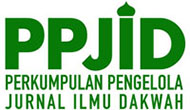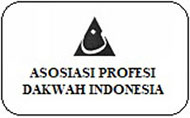Strategi Komunikasi Takmir dalam Memakmurkan Masjid Jogokariyan Yogyakarta (Communication Strategy of the Mosque Management for Prosperity of Jogokariyan Mosque Yogyakarta)
Abstract
The magnificent mosque is not necessarily offset the spirit of the prosperity of the mosque. This is different from the Jogokariyan Mosque in Yogyakarta, in addition to congregational prayers it is also a center of social activities. The purpose of this study was to analyze the takmir communication strategy to prosper the Jogokariyan Mosque. This study uses interpersonal communication theory with a descriptive qualitative approach. The informants of this study were four people from the Jogokariyan Mosque. The results of this study are the personal approach strategy is one of the keys to success in building the communication process. Mosque takmir communication with the surrounding community, worshipers, and mosque visitors is carried out persuasively. Takmir Masjid also often holds social activities with the community, both Muslim and non-Muslim. Efforts to make the mosque prosperous through a personal approach, through hobbies that are favored by residents who have not yet prayed. Besides, the mosque takmir seeks to maintain the comfort of guests whether worshiping or just stopping by.
Keywords
Full Text:
PDFReferences
Adil, M. A. M., Mohd-Sanusi, Z., Jaafar, N. A., Khalid, M. M., & Aziz, A. A. (2013). Financial management practices of mosques in Malaysia. GJAT, 3(1), 23-29.
Zaki, A. (2007). Pentadbiran Masjid Secara Profesional. In Abdul Hamid Othman (Ed.), Islam Hadhari: Kekuatan masjid dalam menjana masyarakat gemilang (pp. 26-49). Putrajaya: Yayasan Islam Hadhari. Ghani, A. M. A. (2013, May 27). Manfaat waktu terluang.
Arifah, S.A. & Zulfa, I. (2018). Peran Takmir Dalam Meningkatkan Kemakmuran Masjid (Studi Kasus Di Masjid Al-Huda Citrodiwangsan Lumajang). Dakwatuna Jurnal Dakwah dan Komunikasi Islam, 4 (2). DOI: https://doi.org/10.36835/dakwatuna.v4i2.447
Cangara, H. (2014) Pengantar Ilmu Komunikasi. Jakarta: PT RajaGrafindo Persada.
Creswell, J. (2007) Qualitative inquiry and research design: Choosing among five approaches. 2nd ed. California: Sage Publication.
Ibda, H., & Saifuddin, K. (2019). Strategi Lembaga Takmir Masjid Nahdlatul Ulama (LTM NU) Temanggung Dalam Mencegah Radikalisme Agama. el-Buhuth: Borneo Journal of Islamic Studies, 1(2). DOI: https://doi.org/10.21093/el-buhuth.v1i2.1604
Instagram: @masjidjogokariyan
Jaafar, A., Habidin, N. F., Hussin, M. M., Zakaria, Z., & Hamid, A. A. (2013). A proposed model for strategic management (SM) and mosque performance (MP) in mosque management. International Journal of Management, Information Technology and Engineering, 1(3), 29-36.
Liliweri, A. (2011) Komunikasi Serba Ada Serba Makna. Jakarta: Kencana Prenada Media Group.
Mokhtar, S. (2003). Status Imam di Malaysia. In S. Norrodzoh & Y. Yusmini (Eds.), Membangun Institusi Masjid. Petaling Jaya: Selangor: Jabatan Dakwah dan Pembangunan Insan, APIUM.
Mohamad, W.A.A. (2008). Pendekatan Baru dalam Pengimarahan Masjid. Paper presented at the Multaqa Imam-Imam Masjid Seluruh Negara 15 April 2008 at Masjid Wilayah Persekutuan Kuala Lumpur.
MUIS (2005). Annual report 2005. Singapore: Majlis Ugama Islam Singapura.
Rogers, M. (1975) “Patterns of Leadership in Rural Malay Community,” Asian Survey, 15(5), pp. 407–421.
Saniei, M., & Delavar, A. (2012). Communicational role of mosques architecture. Asian Social Science, 8(3), 137.
Sapri, M., Kaka, M., & Alias, B. (2010). Performance Management in Service Business: The Facilities Management Function. In Khosrowshahi, F. (ed.) 21st Annual ARCOM Conference. London: SOAS, University of London, pp. 431–40.
Sapri, M., Muin, Z., & Sipan, I. (2016) Key Drivers of an Effective Facilities Management Practice for Malaysia State Mosque. In MATEC Web of Conferences 66, p. 0082.
Saputra, A., & Kusuma, B.M.A. (2017). Revitalisasi Masjid Dalam Dialektika Pelayanan Umat dan Kawasan Perekonomian Rakyat. Al-Idarah: Jurnal Manajemen dan Administrasi Islam, Vol. 1, No. 1, Januari-Juni. DOI: http://dx.doi.org/10.22373/al-idarah.v1i1.1522
Satori, D. & Komariah, A. (2009) Metodologi Penelitian Kualitatif. Bandung: Alfabeta.
Sendjaja, S.D. (1994). Teori Komunikasi. Jakarta: Universitas Terbuka
Sinambela, L. (2010) Reformasi Pelayanan Publik; Teori, Kebijakan, dan Implementasi. Jakarta: Bumi Aksara.
Susanto, D. (2015). Penguatan Manajemen Masjid Darussalam di Wilayah RW IV Kelurahan Banjardowo Kecamatan Genuk Kota Semarang. DIMAS. Jurnal Pemikiran Agama Untuk Pemberdayaan. Volume 15, Nomor 1, Oktober. ISSN :1411-9188(p); 2502-9428 (e).
Utama, I. G. B. R., & Mahadewi, N. M. E. (2018). Metodologi penelitian pariwisata dan perhotelan. Yogyakarta: Andi Offset.
Azhar, A. W. (2008). Financial Management of Mosques in Kota Setar District: Issues and Challenges (Doctoral dissertation, Universiti Utara Malaysia).
Wall & Callister, R. R. (1999). Malaysian Community Mediation. The Journal of Conflict Resolution, 43(3): 343-365.
Wells, B., and Spinks, N. (1999). Communicating with the community. Career Development International, Vol. 4(2), pp. 108-116
Yin, R.K (1996). Studi Kasus: Desain dan Metode. Jakarta: Raja Grafindo Persada.
Yosepin, P. & Husin, B. (2018). Revitalisasi Masjid melalui Kepedulian Sosial Lembaga Takmir Masjid Nahdlatul 'Ulama (LTM NU) terhadap Komunitas Pengemudi. Academic Journal for Homiletic Studies. 12 (1): 121-140. DOI: 10.15575/idajhs.v12i.1939
DOI: http://dx.doi.org/10.24014/jdr.v31i1.9838
Refbacks
- There are currently no refbacks.

This work is licensed under a Creative Commons Attribution-ShareAlike 4.0 International License.
Editorial Office:
2nd Floor, Building of Faculty of Da'wah and Communication, Universitas Islam Negeri Sultan Syarif Kasim Riau. Jl. HR Soebrantas Km 15, Simpangbaru, Tampan, Pekanbaru
Email : jurnalrisalah@uin-suska.ac.id

This work is licensed under a Creative Commons Attribution-ShareAlike 4.0 International License.














